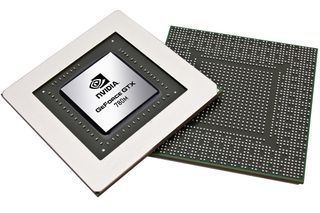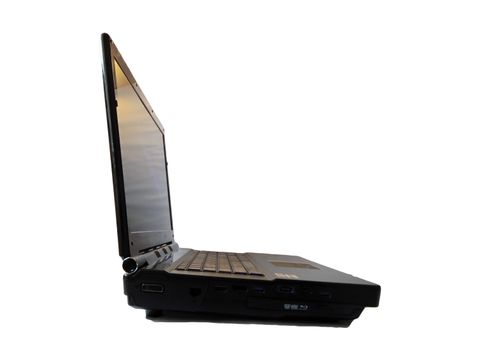IT Pro Verdict
The Eurocom’s extreme price means that this machine will only appeal to a small niche of people, but stratospheric levels of poweracross the board means it’s ideal for those who want to carry out 3D video production, mapping, medical imaging and industrial design. Just don’t expect it to be an easy system to live with: it’s 74mm thick, weighs 5.5kg, and its battery barely lasts for an hour.
Pros
- +
Ridiculous power level; Good screen; Accessible interior; Rock-solid build; Huge customisation options
Cons
- -
Heavy, bulky design; Sky-high price; Dreadful battery life
The Eurocom Panther 5D weighs as much as five Ultrabooks, it's thicker than four MacBook Pros and it's got more power than any laptop on the planet. But with its lack of portability, and poor battery life can the wallet-busting 6,000 price be justified?
Graphical prowess
The primary reason why the Panther comes with such a stratospheric price is because Eurocom has crammed workstation specifications into a laptop chassis. A heavy-duty Intel Xeon processor powers the large 17.3in, Full HD display, which also packs 3D capabilities. This is backed up by two beefy Nvidia graphics cores and a whopping 32GB of RAM.
These two GeForce GTX 780M cores provide outstanding graphical power. They're Nvidia's most powerful mobile GPUs, and are made from the GK104 core used to construct the desktop GTX 770 card. The specifications blow away almost everything else available for laptops: over seven billion transistors, 2,688 stream processors and a mighty 6GB of memory. The base clock of 836MHz isn't exactly shabby to begin with and can be boosted to 993MHz.

The Panther possess a ludicrous level of power, and it battered every benchmark we used. In our standard Very High-quality Crysis test, run at 1,920 x 1,080, it scored 63fps. In 3DMark's high-end Fire Strike graphics benchmark the Eurocom scored 8,573: in the same ballpark as the desktop GTX 780.
Nvidia 3DVision renders two frames at once, so it's no surprise performance suffered - the Panther's Crysis score of 63fps dropped to 27fps. It's still a stellar result, and enough power for the 3D-enabled applications Eurocom reckons the Panther is perfect for from 3D video production and mapping to digital artists, medical imaging and industrial design.
Specs appeal
The Xeon E5-2687W is one of Intel's best desktop workstation chips. It's eight Hyper-Threaded cores can address a mighty sixteen concurrent tasks, and the stock speed of 3.1GHz boosts to a maximum of 3.8GHz on one core or 3.4GHz across every core. The 32GB of memory provides formidable power.
If you need to tackle the most resources hungry applications available, then the Panther will step up to the challenge. The potent specification breezed through our application benchmarks to media, multitasking and overall scores of 1.2, 1.32 and 1.18 the best laptop results we've ever processed. It even trounces high-end desktops: the latest iMac scored 0.96, and the mighty HP Z1 Workstation scored 1.02. Our current favourite laptop, the Retina-equipped Apple MacBook Pro, lagged behind with 0.92.

Powerful devices have a tendency to generate lots of heat so it's a good thing Eurocom's cooling system is up to the job. The processor and graphics card's top temperatures of 83C and 80C are fine, considering they were measured on one of the hottest days of the year. The Panther pumped out a huge amount of noise when stress-tested, and it sucked a mighty 410W from the mains at its peak more than the vast majority of desktops.
The Panther's boot drive is a 240GB Crucial M500 SSD and it's the only component which doesn't blow us away in terms of performance. Its sequential read pace of 497MB/sec is barely behind the world's fastest drives, its sequential write result of 258MB/sec is half as quick as the best SSDs. The 1TB Hitachi Travelstar 7K1000 hard disk is better its read and write results of 122MB/sec and 105MB/sec are good for platter-based storage.
The rest of the specification ticks virtually every box we expect from a high-end work machine. There's Gigabit Ethernet and a Killer Networking dual-band 802.11n Wi-Fi chip, a TPM module and Blu-ray writer.
With the extreme machine containing so many high-end components it's not surprising that the device struggled in the battery test. In our heavy use test, which loops the Cinebench video benchmark on the laptop's High Performance mode and maximum screen brightness, the Eurocom lasted a measly 22 minutes. It's the worst result we've ever seen, and the Panther's light use longevity was barely better while browsing web pages with the screen at 75cd/m2 brightness it lasted for 1hr 7mins. Another record low.
Mike Jennings has worked as a technology journalist for more than a decade and has been fascinated by computers since childhood, when he spent far too long building terrible websites. He loves desktop PCs, components, laptops and anything to do with the latest hardware.
Mike worked as a staff writer at PC Pro magazine in London for seven years, and during that time wrote for a variety of other tech titles, including Custom PC, Micro Mart and Computer Shopper. Since 2013, he’s been a freelance tech writer, and writes regularly for titles like Wired, TechRadar, Stuff, TechSpot, IT Pro, TrustedReviews and TechAdvisor. He still loves tech and covers everything from the latest business hardware and software to high-end gaming gear, and you’ll find him on plenty of sites writing reviews, features and guides on a vast range of topics.
You can email Mike at mike@mike-jennings.net, or find him on Twitter at @mikejjennings



